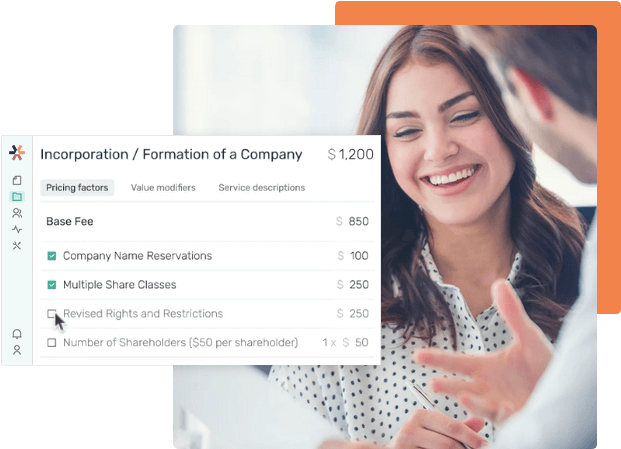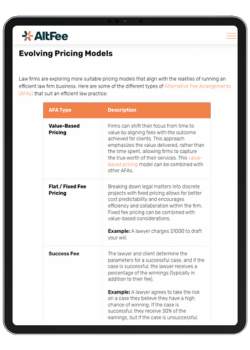- Resources
- Everything You Need to Know About Billable Hours Law Firm
Table of Contents
Abraham Lincoln once said, “A lawyer’s time and advice are his stock in trade”.
And while ol’ Abe was right, he probably didn’t mean that lawyers should track their time in 6-minute increments and otherwise be held hostage to timesheets.
If he could rise up and clarify his statement to the good people of the United States today, odds are good that this intelligent leader would recognize that hey, maybe the billable hour wasn’t the best choice for charging people for legal services.
Still, the idea for the billable hour didn’t just pop up out of thin air as a way to add stress to the legal profession, there were real, actionable reasons behind its adoption.
This article explores those reasons and explains more about the billable hour, including how it works and why it was implemented in the first place. Then, we’ll get into the pros and cons of the billable hour, and explore alternative pricing options that law firms and legal professionals can implement instead.
Ready to track your time? Let’s get started!
What Are Billable Hours for Lawyers
The idea behind law firm billable hours is simple: the lawyer sets an hourly rate, and the client pays it.
It’s simple to explain, and the lawyer can even give an estimate of how long the job will take to give the client a better idea of what their final bill will look like.
On paper, the billable hour is a straightforward way for law firms to keep track of client fees and monitor billing targets for the year.
The billable hour has been a standard way of charging clients for legal services for decades. If you went to see a lawyer anytime after the 1960s, chances are you wouldn’t know what the legal services you’re seeking would cost in the end, you’d only know what the lawyer charges per hour.
How Do Billable Hours Work for Lawyers
While pre-1960s law firm pricing focused more on lawyer experience, the time taken to complete a legal matter, competitor prices, and other factors, the billable hour ultimately became the most popular way of charging clients for legal services.
But it wasn’t without reason. In the 1930s through to the 1940s, the idea of increasing attorney incomes became a focus for state bar associations. While flat fee billing for legal services was still popular, law firms could adopt “minimum fee schedules” that aimed to standardize pricing for legal services. This meant that if a legal professional charged less than what these minimum prices set out, they could face disciplinary action by the state bar.
But these minimum fee schedules would soon face a reckoning by way of the Goldfarb v. Virginia State case.
In 1975, Ruth and Lewis Goldfarb wanted to buy a house in Fairfax County, Virginia. But in order to get a mortgage, they had to do a title search on the house, which could only be done by a lawyer. The problem was that every lawyer he contacted refused to charge less than the minimum fee schedule set out for that service. Arguing that the set fee amounted to a form of price-fixing, the Goldfarbs sued the Virginia State Bar and the County Bar.
The supreme court’s decision that minimum fee schedules violated antitrust laws in the case would solidify the billable hour as the primary way to charge for legal services.
From then on, timesheets, hourly rates, and the stress of negotiating client bills became a reality for lawyers in the United States.
How Do Lawyers Calculate Billable Hours
Billing by the hour might not be as simple as charging a set hourly fee for all of the legal services a lawyer is offering. Instead, careful thought and planning need to be done to ensure that fair rates are presented that are competitive and reflect the value offered to the client.
The ABA has rules that outline how a lawyer should calculate what their hourly rate should be. The purpose of these rules is to keep fees within a reasonable range for an area. But what is “reasonable” depends on a lot of factors, including the scope and difficulty of the project, lawyer experience, and what other lawyers in a jurisdiction charge for the same service.
Setting Competitive Rates
Pricing your services to be competitive with other law firms and lawyers in your area that offer the same legal services requires research. You can use a resource like Clio’s Legal Trends Report to find out average hourly rates for lawyers in your area, as well as your industry connections to determine what price you should set.
Aside from networking and looking at law firm billable hours indexes to set your prices, you can also check out the websites of the various lawyers and law firms in your area. But if they use hourly billing, chances are you won’t find an amount listed plainly on their website.
There are a number of reasons for this that make sense, including that different legal services will likely be priced differently, and that hourly rates may increase or decrease depending on the scope of the project.
In order to stay competitive, it’s important that you revisit your pricing strategy at least annually so that you can ensure that your pricing still aligns with industry trends and what other lawyers are charging in your area.
Billable Hours Law Firm vs. Actual Hours
Billable hours refer to the time a lawyer spends on a legal matter, with that time being billed directly to the client.
Non-billable hours refer to the time spent on other tasks, like data entry and other administrative work.
A law firm typically tracks both of these types of hours for every lawyer.
It’s no secret that law firms are focused on profitability. After all, a law firm is a business. But if the firm is using the billable hour for lawyers, a lawyer is incentivized to charge the maximum number of hours that is reasonable to a client.
This is mainly because under a billable hour model, the average lawyer is expected to submit a certain number of hours per year, usually between 1,700 and 2,300. If a lawyer has enough clients to consistently fill an 8-hour workday for an average of 250 working days a year, meeting this target isn’t a problem. However, when we consider non-billable hours, and things like vacation, sick time, and non-billable time, meeting this target suddenly becomes more difficult.
In reality, lawyers often overwork themselves and underreport time in an effort to meet targets but also keep client bills reasonable.
Of course, the law firm should account for vacation and sick time, as well as part of a lawyer’s workday to include non-billable hours, like performing administrative tasks, but the pressure on the lawyer to bill more to clients is always there.
For example, if the client sends an email and the lawyer takes a few minutes to respond, should that time be billed to the client or not? If the lawyer is in the middle of drafting a document and grabs a coffee, should she time herself and remove it from the client’s bill, or just leave it?
To bill clients fairly and meet annual targets, careful consideration needs to be given to what constitutes a billable task and what does not.
Pros & Cons of Billable Hours
Now that we’ve discussed how billable hours for lawyers work and how they can be calculated, let’s take a closer look at the pros and cons of billable hours law firm.
|
Pros |
Cons |
|
Straightforward and easy for the client to understand (e.g. Lawyer A charges $150 per hour, you pay for the total hours it takes for the lawyer to complete the task) |
Doesn’t offer price certainty; clients don’t know how much their final bill will be |
|
Easy to calculate (rate x total number of hours) |
Requires careful time tracking (lawyers commonly track their time in 6-minute increments) |
|
Rates can be easily adjusted to match the scope and difficulty of a legal matter (i.e if more time is taken, a client will simply be billed more) |
A higher final bill increases the likelihood that a client will want to negotiate a lower bill, leading to write-offs and discounts |
|
Less risk than flat-fee billing (if the task takes longer than expected, that time can be added to the bill) |
There is low incentive for lawyers to be efficient with completing legal work |
|
Less focus on experience and more on pricing yourself to be competitive |
Increased focus on the lawyer that charges the least rather than the lawyer that is the most experienced and knowledgeable with a legal matter |
|
|
May lose work to firms that offer alternative fee arrangements (AFAs), such as flat-fees as these offer more price certainty for clients |
|
Could be seen as an unethical way to bill clients, since clients have no idea how long it should take for a lawyer to complete a legal matter |
Billable Hour Alternative Options
It’s important to note that the conversation around the billable hour for lawyers and whether it's the best way to charge for legal services is shifting in favor of alternative fee arrangements.
There’s a plethora of evidence out there in legal reports and surveys that point to clients wanting better experiences when seeking out and purchasing legal services.
In short, clients are tired of accepting the uncertainty of what a lawyer will actually cost them and instead have been gravitating towards law firms that have responded to the evidence and adjusted their billing strategies accordingly.
As a result, law firms and legal professionals have adopted alternative fee structures that offer clients:
- Better price certainty
- Increased transparency with how legal services are billed
- A bigger focus on communicating perceived value rather than a price tag
- Increased access to legal services (people are more likely to access legal services when they know how much a service will cost)
In addition, lawyers and law firms benefit from:
- An overall more efficient and profitable law firm, according to Bloomberg Law’s 2021 Legal Operations Survey
- Overall better working conditions with less of a focus on recorded hours and more of a focus on efficiently completing client projects
- Alignment of client interests with the interests of the law firm
- Being able to offer clients more options to pay for their legal fees (e.g. unbundled legal fees that give the client the option to only pay for what they need, and therefore the lawyer performs only that work)
Seems like a win-win situation, right? Clients are happy, lawyers benefit from better working conditions, and those tough conversations around the cost of final bills are all but eliminated since the client knows what they’ll pay before work even starts.
But there are quite a few different alternative fee structures to choose from, and sorting out what you’ll use for each legal service that your firm offers might be a little daunting at first.
Examples of alternative fee structures include:
|
Alternative Fee |
Description |
|
Subscription or Periodic |
Charges a monthly or annual fee to a client for ongoing access to a predetermined set of legal services |
|
Fixed or Flat |
The legal service is charged at a set price that covers an agreed upon scope of work |
|
Fixed Portfolio |
Provides a fixed-fee billing solution for larger businesses that need access to a number of legal services at one time |
|
Staged or Phased |
The client pays a fee once certain milestones are reached during a legal matter |
|
Contingency |
A set fee (often a percentage of winnings) that the lawyer received upon the successful outcome of a legal matter (e.g. a trial is won) |
|
Fee Collar |
A set fee is agreed to in advance, but the total fee paid by the client depends on the lawyer’s time on that matter falling within an agreed upon range. If the lawyer’s time falls outside that range, a higher or lower fee may be paid |
|
Sliding Scale |
The client is charged for a legal matter based on their ability to pay (e.g. income level) |
|
Success |
The lawyer receives a bonus payment if the predetermined definition of success of a legal matter is met |
Those are quite a few options, right? So how can you match the best ones with each legal service that you offer?
One of the best ways you can go about setting your AFAs is by using AltFee’s alternative fee arrangement pricing software.
With AltFee, you can build a pricing system for all your legal matters based off of their extensive catalogue of template guidelines (or, create your own from scratch). As new client projects come up you can easily customize an existing pricing guideline specific to the parameters of that new project. But the real draw is the built-in collaboration features; AltFee provides your team with the ability to soak their learnings back into the template guidelines so that projects that come up in the future can be continually better scoped and priced to maximize value to client and profit to the firm. This ensures that communications aren’t misunderstood, confused, or lost, and helps improve pricing efficiency and accuracy as your practice grows.
Start Earning More Revenue with Fixed Fees
Break free from hourly pricing and take the fear out of scoping and pricing client projects to start maximizing profitability.
Book A Demo
Q&A

What is a normal amount of lawyers' billable hours?
Although a typical full-time job runs somewhere in the ballpark of 1,800 hours per year, the typical amount of billable hours for lawyers ranges between 1,700 to 2,300 hours.
What percentage of time should be billable in a law firm?
Based on the average acceptable billable hours target for law firms, about 66% of lawyers time should be billable. However, the 2021 Clio Legal Trends Report states that the average law firm is only billing 31% of their time.
How many hours do most lawyers work in a week?
According to several sources, including the 2018 Clio Legal Trends Report and a recent analysis from Bloomberg Law, most lawyers work between 50-80 hours per week.
How do lawyers track their time?
While sticky notes and pads of paper may still linger in some law firms, the modern way lawyers track billable and non-billable hours are usually through time tracking software or by using a billable hours chart.
Here is an example of a chart that could be used to track lawyers' billable hours:
|
Time Increment |
Minutes |
|
0.1 |
1-6 minutes |
|
0.2 |
7-12 minutes |
|
0.3 |
13-18 minutes |
|
0.4 |
19-24 minutes |
|
0.5 |
25-30 minutes |
|
0.6 |
31-36 minutes |
|
0.7 |
37-42 minutes |
|
0.8 |
43-48 minutes |
|
0.9 |
49-54 minutes |
|
1.0 |
55-60 minutes |
Do lawyers get paid for non-billable hours?
Whether or not a lawyer gets paid for non-billable hours depends on the law firm. If the lawyer is paid a salary, then they’ll get paid for non-billable hours.
Conclusion
Although the billable hour has been the popular choice for both law firms and solo practitioners for decades, it’s being used less and less as time goes on. Clients are tired of the uncertainty with their final bill that comes with hiring a lawyer who bills by the hour, and lawyers are tired of having to negotiate bills with clients, as well as working long hours to meet yearly hour targets and finish legal matters.
As the conversation continues to shift away from the traditional hourly billing model, law firms will need software to help set out their AFA pricing models. AltFee is an easy-to-use, effective AFA pricing software that focuses on collaboration. Legal professionals with your law firm can leave insights and notes on each pricing guideline, making it easy to make adjustments and tweaks to your pricing strategy on the fly.
Want to learn more? Get a demo today!
Start Earning More Revenue with Fixed Fees
Break free from hourly pricing and take the fear out of scoping and pricing client projects to start maximizing profitability.
Book A Demo





Newsletter Signup
Subscribe to our newsletter to receive the latest news.





